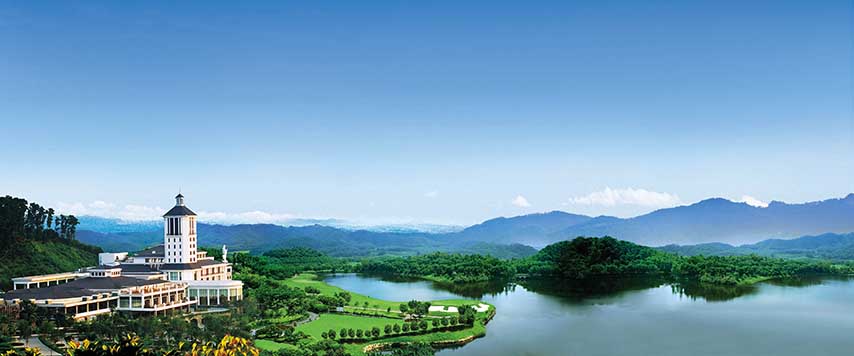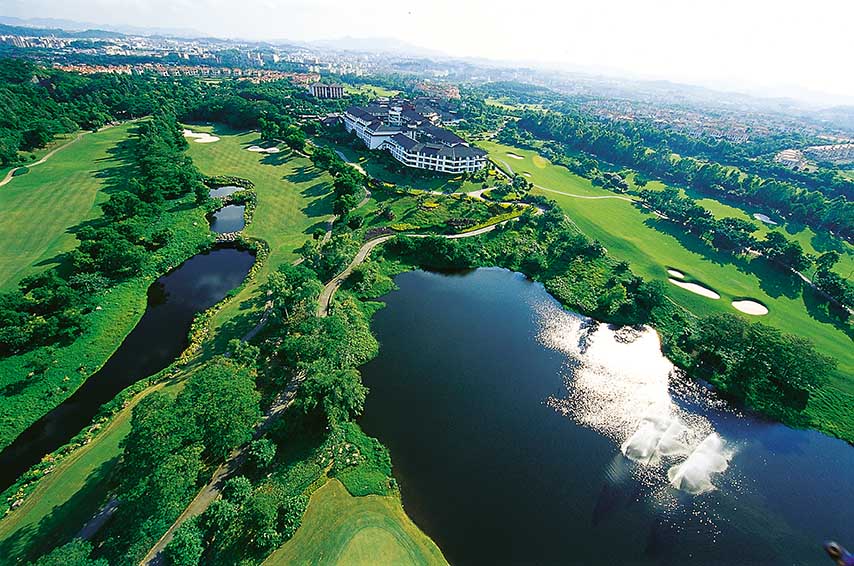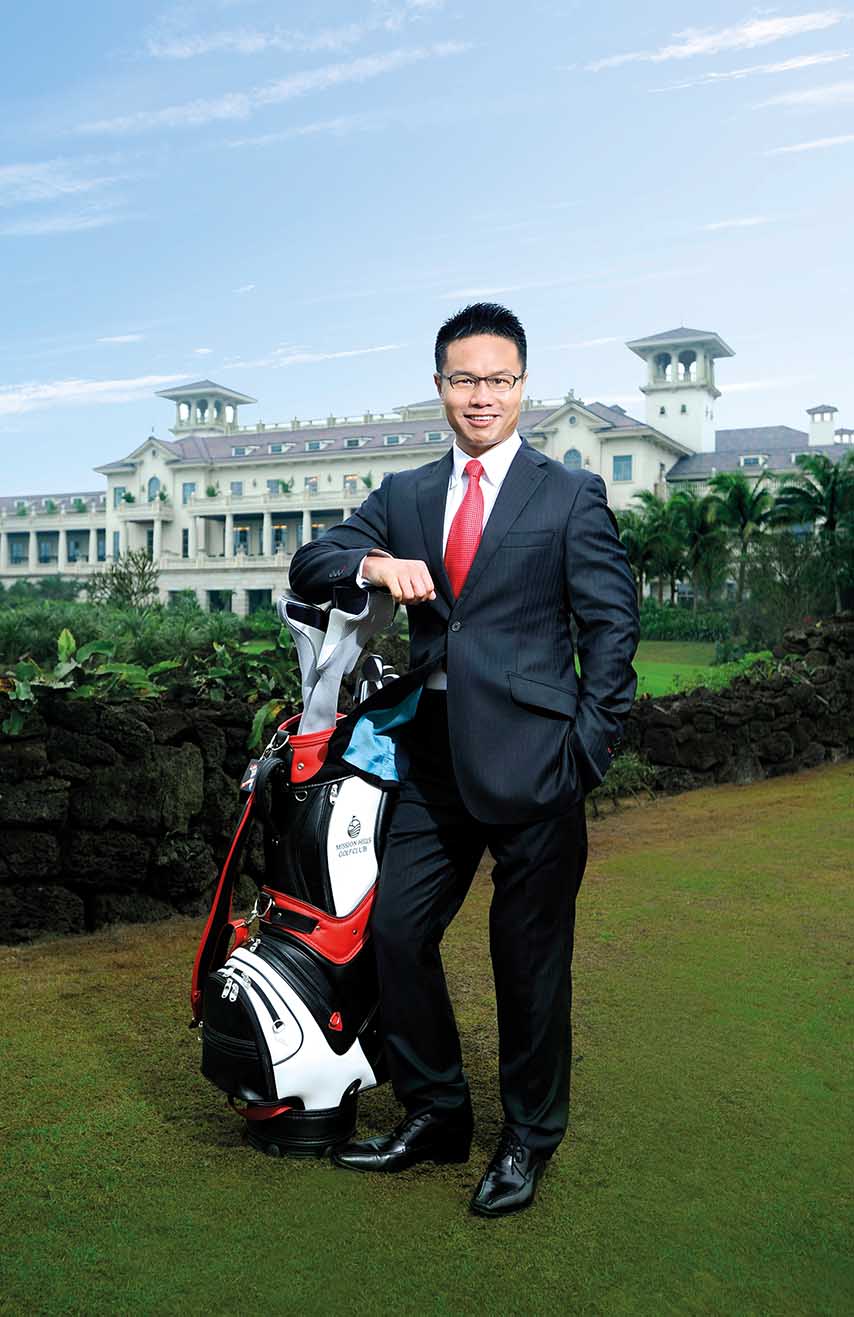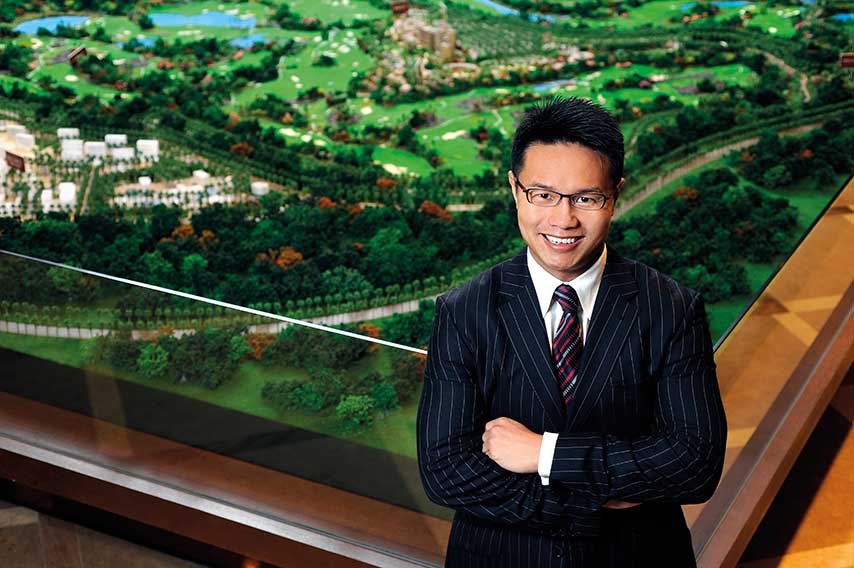“By 2020, China is predicted to be the world’s number two golfing nation, with 20 million golfers”
He is known as China’s “Mr. Golf”. Born in 1974, Dr. Ken Chu is head of the world’s largest golf complex and one of the planet’s most impressive leisure empires. His entrepreneur father, David Chu, had the initial vision that this strange sport played in other countries, using a club and a small ball, could have a bright future in China. And he was right.
Within barely one decade, thanks to the driving impetus of Mission Hills, golf has experienced unstoppable growth in this Asian country, currently with 600 courses and around five million golfers, according to estimates by Ken Chu, chairman and CEO of Mission Hills Group. His family’s business empire was founded in 1992, eight years after the first golf course was built in China following the era of Mao Tse-tung, who banned it as being too bourgeois.
Dr. Chu talks about the pacesetting Mission Hills Group and golf in China in general, in this exclusive interview with Andalucía Golf.

It is now 25 years since Mission Hills Group was founded. How has the group contributed to the development of golf in China during this period, highlighted by the construction of two major resorts and 22 golf courses in total?
Bearing in mind golf’s entire 550-year history, my father with his vision, courage, strategy and tenacity established the unprecedented and monumental Mission Hills resorts within 10 years. He was a forward thinker, converting wasteland in Shenzhen and Hainan into the world’s largest golf club. Frankly, in the past no one would have envisioned that, one day, the world’s largest premier golf facilities would be standing in its place. He established China as the centre of golf and made a statement that China was ready to compete with the world’s most famous resorts.
Mission Hills has been the major driving force behind China’s sports and leisure industry. We have hosted more than 100 international tournaments. Mission Hills’ properties sprawl over 40 square kilometres, including 22 championship courses designed by renowned players and architects from five continents, five-star resorts, award-winning spas and volcanic mineral springs, international convention centres, golf academies and Asia’s largest tennis facility. Mission Hills is also the official training headquarters for China’s tennis, football and golf associations.
Mission Hills’ successful recipe is based on the vision that still stands today, that is to promote international goodwill through golf. Now having been passed on to my generation, I purely add some extra ingredients to enrich this vision.
The evolved vision is now “golf and more”. I am a disbeliever in “golf widows”. Thus, we built up a whole range of amenities beyond golf such as spa, retail, entertainment and kids’ facilities for the wife and children to enjoy their time at Mission Hills while the husband goes out to the golf course. This “game-changer” tactic has attracted the non-golfing population to visit a golf destination as a family while personalising their leisure experiences, and opened doors for the game that has been traditionally male-dominated in Asia. Of course, we also encourage both the ladies and the young to play golf with our annual ladies golfing events and series of junior tournaments. Furthermore, juniors under 16 enjoy free access to three of our golf courses as part of the group’s commitment to junior golf development in the region.

What projects are being developed by Mission Hills Group at the moment, and what expansion plans are envisaged in both the short and medium term?
The group’s “golf and more” leisure philosophy has catalysed our tourism-related business expansion into a leisure hub for multi-generational families. Mission Hills Centreville Shenzhen and Haikou are two HOPSCA (Hotels, Offices, Parks, Shopping, Culture and Arts) mixed-use developments with a focus on "retail-tainment” and “edu-tainment", providing integrated recreational, business, education, entertainment, shopping, leisure and cultural experiences. The group has also extended its foray into the hospitality industry by partnering with world-renowned hotel brands such as Hard Rock, Renaissance and the Ritz-Carlton. This collaboration has seen the opening of the Ritz-Carlton’s first golf resort in Haikou as well as the impending launch of Hard Rock Hotel in Shenzhen – the first Hard Rock Hotel in China.
Other significant projects include Movie Town in Haikou in partnership with China’s largest film production company, Huayi Brothers Media Corporate, and award-winning director Feng Xiaogang, and China’s first Wet’n’Wild park in collaboration with Australia’s leading entertainment group and largest theme park operator, Village Roadshow Limited. Wet‘n’Wild Haikou features the world’s biggest and newest collection of thrilling slides and attractions for the entire family.
In March 2016, Mission Hills partnered with six-time grand slam champion Boris Becker, aiming to develop the sport in China and unearth future Chinese grand slam champions. In conjunction with Mission Hills, the tennis superstar created the world’s first Boris Becker Tennis Academy here in China.
In February 2017, Mission Hills partnered with Fútbol Club Barcelona (FCB) to jointly open a major football academy in Haikou. The FCB Escola in Haikou will be the first overseas FCB football school directly managed by FCB. The FCB Escola in Haikou will be staffed by FCB coaches and will follow the same training methods used by the FCB youth teams. FCB and Mission Hills will also open an interactive FCB Barcelona experience area in Mission Hills Haikou. With the grand opening scheduled in 2017, the 7,000-square metre FCB facility will offer visitors an immersive and interactive experience to bring people closer to the Barça brand, highlighting its stars and their stories, as well as the legendary club’s history, philosophy and values. It also houses a food and beverage outlet and offers official FCB merchandise for sale.
My plan and strategy for the future is to continue to play the role of a super-connector, bringing into China more international brand offerings and experiences ranging from F&B, entertainment and retail to health and wellness. Mission Hills will continue to open new markets and explore novelty projects to offer visitors a more diverse and vibrant experience.

How many total rounds are played annually at Mission Hills’ 22 courses, and what are the players’ predominant nationalities?
There are over 16 million visitors annually to Mission Hills, out of which 1.5 million visitors are golfers. Mission Hills’ developments not only attract visitors from China, but also many other countries such as Australia, Russia, the US, UK and Korea.
Would it be true to say that Mission Hills is the leading business group that has invested most in China’s tourism industry to date? What figures are we talking about, over the past 25 years?
Founded in 1992, Mission Hills is recognised as the leading golf brand in the world and is synonymous with leisure, wellness, entertainment and luxury residences. A pioneer in China’s hospitality, sports and leisure industry, Mission Hills brought golf to China and has been the major driving force behind China’s sports and leisure industry ever since. With integrated leisure destinations in Shenzhen, Dongguan and Hainan, Mission Hills has hosted more than 100 world-class international tournaments and invested more than US$5 billion in China over the past 25 years.
There is some disparity in reported figures for the number of Chinese who play golf and the number of golf courses in China. What are the approximate figures, and what expectations are there for growth over the next few years?
The demand for golf in China is increasing at an exponential rate. Let’s examine the supply and demand situation for golf in China and, for the sake of comparison, the US and Japan.
In the US, there are 18,000 golf courses and 26 million golfers; in Japan, there are 2,500 golf courses and 13 million golfers,
In China (population 1.5 billion), where the game was introduced a little over two decades ago, there are about 600 golf courses and five million golfers.
As you can see, there is enormous room for growth. By 2020, the China Golf Association predicts there will be about 20 million Chinese golfers, making China the world’s number two golfing nation.
In 2004, the Chinese government banned the construction of golf courses, on the grounds that there had been general illegal use of farmland. The island of Hainan, where Mission Hills Haikou was built, was not affected by the ban as it is in area considered to be of special interest for tourist development. What is the current policy of the authorities in this respect? Is construction of new courses now being permitted?
Many courses were closed for extracting groundwater illegally, or using large amounts of arable land or nature reserve areas. I endorse what the government has done, especially since the ban was meant to conserve farmland and water supplies to cater to the larger population.
Mission Hills Shenzhen and Dongguan were constructed on a barren plot of wasteland in the desolate outskirts of Shenzhen and Dongguan with no infrastructure and were uninhabitable. Similarly, Mission Hills Haikou was built on a barren landscape of lava rocks where for 10,000 years no one had lived on the site. Breathing life to the otherwise uninhabited plots of wasteland, Mission Hills not only provided jobs for the local community, but also focuses on responsible development in the context of the community, culture and environment.
Sustainable development is one of the key guiding principles at Mission Hills. Understanding the importance of protecting the environment and ecology, Mission Hills has in place various initiatives to reduce carbon, energy and water consumption across our resorts to minimise any negative impact due to our operations.

The price of green fees or golf club memberships, and even practice amenities, is not within the reach of most of the Chinese population. What can be done to make it easier for these Chinese, who would like to play golf, to take up the sport? Would it help if the Chinese authorities boosted the development of public (or government-owned and run) courses?
In the past, 99 per cent of the golf clubs in China have been membership-based. As the economy moves forward and the standard of living improves, more Chinese will take up golf. The leisure and tourism industry in China will continue to develop and grow. In China, golf is more driven by domestic but also by international demand. Much of that will come down to location.
However, compared with US, golf is still in its infancy stage in China. It is Mission Hills’ mission and goal to popularise the game of golf in China. What we are trying to do is to expose more people to the game, and let them see and experience for themselves that golf is not just a sport for the elites, but one which offers physical and mental health benefits and can be played and enjoyed by everyone. That’s why we created the world’s largest public golf club in Mission Hills Haikou.
There are two challenges to the game’s continued growth in China: visibility and accessibility. We’ve developed a three-pronged initiative to address them…
Bring the world’s biggest tournaments to China. Develop new tournaments on Chinese soil that have the potential of one day becoming China’s own brand of famous tournaments (for instance, the Mission Hills Celebrity Pro-Am). Nurturing the champions of tomorrow via a variety of junior programmes and instructional initiatives in order to be able to provide inspiration for future generations of players. Some examples include the Mission Hills Golf Series Junior Tour, our partnership with the Faldo Series and the ANNIKA Invitational at Mission Hills, etc.
In contrast to what is happening in China, the number of golfers in many other countries with much longer golf traditions is decreasing, due in great part because younger generations are not as interested in the sport. What do you believe can be done to make golf more attractive for young people?
Mission Hills is building a holiday destination suitable for multi-generations to have quality time and fun together. Our vision is to be a leading world-class brand and a pioneer in the global leisure and tourism industry. The group’s mission is to advance over time and inspire “3H – Happy, Healthy and Harmonious” lifestyles and experiences for all. What I am trying to do is to create a platform for business, leisure, family gatherings and multi-generational projects which can be enjoyed by all.
Mission Hills’ successful recipe is based on the vision that is still valid and very relevant today; that is to focus on advocating golf in line with the “3As – Available, Affordable and Acceptable”, and establishing MH in the number one position in the golf world. As I mentioned before, when it was passed on to my generation, I added some extra ingredients to enrich this vision several years ago, “golf and more”, building up an international leisure resort brand blending golf with elements including sports, hospitality, health and wellness, travel, conferences, education, culture, cuisine, shopping and property development.

The World Cup of Golf was held at Mission Hills Shenzhen in 1995, the first major international golf tournament played in China, and it was televised throughout the country. In 2001, Tiger Woods was invited by Mission Hills to visit China for the first time. How important are these kinds of events in helping to promote golf in your country?
It has always been Mission Hills’ vision to promote international goodwill through golf. We’re committed to growing the game of golf in China. China has the largest population and the development of golf in China will create a foundation for a strong game globally. With the hosting of various international tournaments, Mission Hills has provided an opportunity for the Chinese to watch the game played at its highest level in person.
Broadcasting of the international tournaments has proven to be very successful. It is a vehicle to bring the world to China and introduce China to the world. The recent Mission Hills World Celebrity Pro-Am was a star-studded event bringing together world famous celebrities with leading international golfers on the award-winning 7,777-yard Blackstone Course. This glittering event was broadcast in more than 200 countries and more than 500 million households watched the tournament. International tournaments spark public interest in the host venue and reinforce Haikou’s international tourism reputation and influence.
Bringing international tournaments to China helps to create and incubate new tournaments on Chinese soil. Potentially, China will one day create its own brand of famous international tournaments too. On the other hand, international tournaments also support the cultivation of competitive golfers in China. The many programmes and initiatives for junior golfers held during the tournament week open doors for them, empowering them to enter the world stage and compete internationally.
Professional Chinese golfers are making great strides around the world, and there are already some rising global stars. Chinese golfers have had success on the European Tour, including Li Haotong’s victory in the 2016 Volvo China Open, and the women’s game was highlighted by Feng Shanshan’s bronze medal in last year’s Olympics in Rio de Janeiro. How do you see the immediate future for China’s top professionals? Feng has already won a major (the 2012 LPGA Championship) but could the men also be on the verge of winning a first Grand Slam title?
Golf has returned to the Olympics after an absence of more than 100 years. Feng Shanshan secured the bronze medal in last year’s Olympics in Rio de Janeiro. Li Haotong together with Wu Ah Shun were runners-up in the team competition of the World Cup of Golf last year. These exposures certainly bring the new players into the game and also encourage junior golfers and professional golfers in China to achieve their dreams. It will help dramatically, similar to how Yao Ming has transformed basketball for China. We do need our golf heroes to help give it a greater push to popularise the game.
In recent years, the Chinese authorities have ordered the closure of over 100 golf courses, and in 2015 the Communist Party – acting against alleged corruptive practices in relation to golf-related gifts – banned its 88 million members from playing the game, although that ban was lifted last year. How did these measures affect golf in China?
To some, golf is still perceived as an affluent game, because the golf population is much greater than the supply of golf courses and golf in China is still at its infancy as it is only 30 years old. Ninety-nine per cent of the clubs are membership-based; hence it may be perceived by some as a luxury game. What Mission Hills has done is to continuously be the pioneer in the development of the game, such as positioning Mission Hills Haikou to be a non-membership public golf club, thus removing the barrier to playing golf. One no longer needs to invest in an expensive membership to be able to play golf.
Finally… For someone in Europe planning an overseas golfing holiday, what are the main reasons why they should choose Mission Hills?
Mission Hills is an international integrated resort destination which caters to families and multi-generations – with leisure and lifestyle experiences ranging from golf at the award-winning championship courses, pampering at the world largest spa and hot springs, international gourmet dining options and mineral hot springs featuring the characteristics of five continents, as well as theme parks and attractions.
Known as the “Hawaii of the East”, Hainan boasts clean air, clear blue skies, a unique volcanic landscape, pristine beaches and pleasant tropical year-round weather. Haikou, the capital of Hainan, consistently ranks amongst the top cities in China with the best air quality, excellent water quality and ecology. The climate is a paradise for those looking to escape the harsh winter.
Furthermore, citizens of 26 countries are exempt from visa requirements when visiting Hainan Province, and the island offers hassle-free visas on arrival for others.




